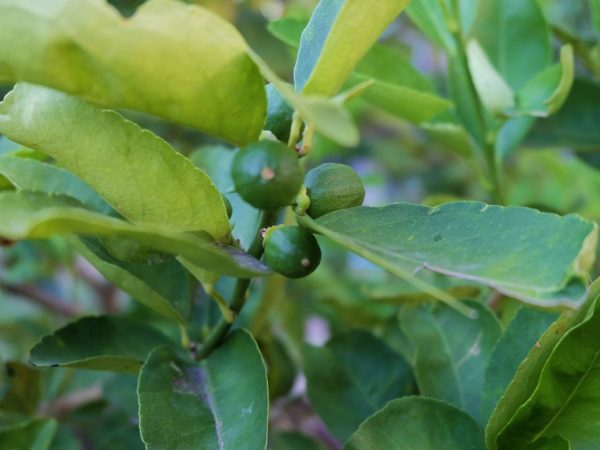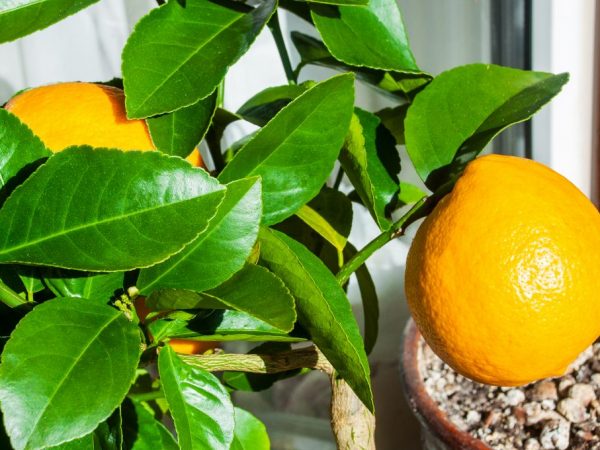Reasons for falling leaves in indoor lemon
Lemon is a hybrid evergreen citrus plant. It is cultivated indoors for fruit and for decorative purposes. The plant is whimsical to growing conditions, but it is resistant to diseases. If lemon leaves fall, this is a symptom of a violation of the rules of care.

Reasons for falling leaves in indoor lemon
Causes of foliage loss
Indoor lemons lose green leaves for the following reasons:
- insufficient lighting;
- excessive soil moisture in the pot;
- lack of sufficient nutrients in the soil;
- dry indoor air;
- excess of applied fertilizers;
- incorrect transplantation into a new container;
- insufficient amount of water;
- low ambient temperature;
- a sharp change in the place of cultivation;
- temperature drops.
Lemons are conditionally deciduous plants. The loss of foliage in winter is not a natural process, but a symptom of the influence of external factors on the plant. The presence of one problem causes slight loss of leaves and their yellowing. If lemon leaves fall, then there are several negative factors.
Influence of light
Improper lighting is one of the most common causes of foliage in home trees. The main time of lack of light for lemon is winter. During this period, the fruit needs more ultraviolet radiation, since the air in winter is cold and less humid.
Lemon lighting rules in winter:
- Location. The plant thrives better on a windowsill on the south or east side. It is forbidden to grow indoor lemon near heating appliances: they will cause drying out and loss of foliage.
- Using mirrors. To prevent the sheets from drying out, they are placed around the plant. This is how they reflect the sun's rays. As a result, the lemon receives a sufficient amount of ultraviolet radiation.
- Lighting. If it is not possible to provide indoor lemon with natural lighting, artificial lighting is used. For this, the plant is illuminated with special ultraviolet lamps or daylight devices.
If the lemon has dropped its leaves in warm seasons, change its place. Choose a window sill that receives direct sunlight for at least 3 hours a day. In summer, the plant is taken out onto the terrace or balcony.
Watering
Homemade lemon sheds its leaves due to over-watering. This causes stagnation of water in the ground, waterlogging occurs. The soil becomes not loose enough. The roots do not receive the required amount of oxygen. This causes stress on the plant, which is determined by the fact that the leaves have fallen.
As a result of waterlogging in a houseplant, roots and capillaries die off. Root nutrition is impaired, which affects the condition of the tree crown. New shoots are not formed, and there are not enough useful elements to maintain the old ones. The leaves begin to turn yellow and fall off. Also, waterlogging causes the appearance of fungal diseases of the roots and branches of the tree.
Lack of moisture
A small amount of added moisture also negatively affects the lemon.Drying and curling of leaves is a symptom of the drying out of the soil layer. Dead leaves of homemade citrus fruits gradually fall off, and there is not enough moisture for the development of new ones.
With a lack of moisture in the roots, their endings die off. The circulation of juices in the trunk and branches deteriorates, the plant enters the stage of stress and dies. Flowers and ovaries do not appear.
To restore the condition of the lemon. if the leaves have dried up, restore watering. It is impossible to abruptly introduce moisture into the dried soil: this will lead to an excess of water in the root system and, as a result, to disease.
The lemon tree is reanimated gradually. Before watering, the foliage is sprayed so that the crown is saturated with moisture. Then moisture is gradually introduced into the soil. Its amount is increased with each new application, until the normal state of the lemon is restored.
Climate

Spray the plant regularly
Young citrus requires constant spraying of the crown under normal conditions. A suitable temperature for the development of a houseplant is 18 ° C-20 ° C. In the hot season, plants are sprayed 2-3 times a week.
In winter, the number of procedures depends on the power of the heating devices. If the air is warm, and the plant dries and throws off the leaves, spraying is carried out daily. At a cool temperature, 2-3 procedures are performed per week.
If moisture is not brought in on time, and the air is dry, the leaves will fly around. To revive it, the plant is regularly treated. Also, room lemon is placed away from heating devices or covered with a cloth during the day. Lack of moisture will stop buying a humidifier.
Cold air
In winter, lemon feels fine at a temperature of 12 ° C-14 ° C. In colder air, the plant sheds its leaves. Growing lemon in the winter on an unglazed balcony or street is prohibited.
In order to restore a plant, it cannot be abruptly brought into heat. Lemon does not tolerate sudden changes in temperature, and therefore will lose even more leaves from the crown.
The room temperature is increased gradually. During the care, the condition of the leaves and shoots is carefully monitored. If they look better, increase the temperature slightly. Also, the tree is protected from drafts.
Soil depletion
Soil for growing lemons should contain:
- zinc;
- potassium;
- cobalt;
- iron.
Also, the plant requires regular application of phosphates and natural fertilizers from humus, deciduous soil, peat and ash. They are needed for the active growth of shoots, maintaining the crown, the appearance of the ovary and fruits.
Signs of a lack of nutrients in the soil:
- the appearance of yellowness on the leaves;
- withering of the crown;
- changing the shape of the sheet;
- drying of shoots.
If the soil is not saturated with minerals in time, the tree will lose its foliage, and the fruits will stop developing. To prevent the bush from shedding foliage, top dressing begins to be applied regularly.
In the summer, mineral fertilizers and organic substances are applied 2 times a month. In cold seasons, top dressing is applied once a month. If the tree does not bloom, no phosphorus is added.
Pests and diseases
Lemons also drop leaves when infested with pests:
- Shield. She feeds on the sap of the tree, which causes a lack of them in the foliage. The symptom of the disease is small holes in the leaves.
- Aphids. It feeds on substances from the leaves, which causes them to wilt and dry out. Identified by the presence of small black dots.
- Spider mite. Appears during the flowering period. Identified by the spider web on the branches.
The actions of pests cause the plant to dry out, its leaves crumble. Chemicals are used to fight, as well as folk methods. A decoction of garlic and onion skins helps a lot.
To get rid of aphids, rub the green leaves until they have fallen off. A soapy solution can also help for spraying against pests.
Lemons also fall off due to fungal infections. They appear when there is an excess of moisture in the soil, they affect the branches and the root system.To reanimate the lemon, all affected segments are removed, the wounds are treated with growth stimulants. The plant is transplanted into new soil.
Conclusion
In order to prevent the death of a home plant, it is necessary to properly care for it. A healthy lemon produces a lot of fruit and blooms beautifully. When growing, it is forbidden to abruptly change the room. Night temperature is monitored in summer.
To combat fallen leaves, prophylaxis is carried out so that he does not throw off the lemon. Also, a houseplant requires crown formation and regular transplantation into a large container.


